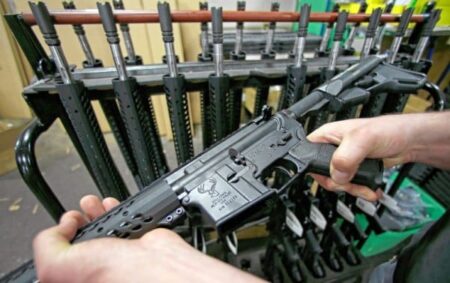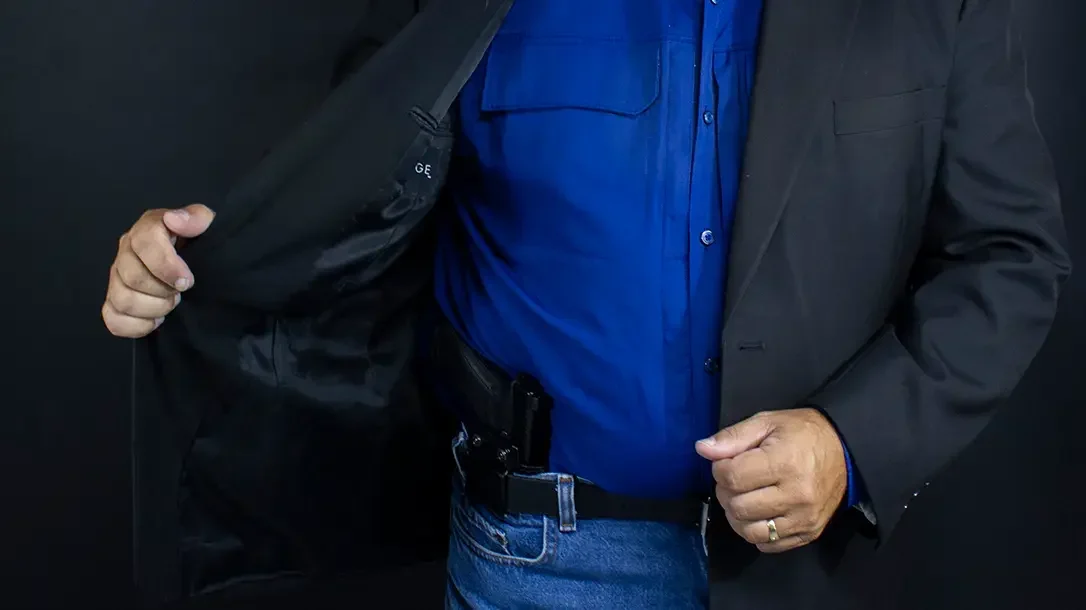The Colt Single Action Army (SAA) was the iconic sixgun of the Old West. It was introduced for the military in 1873, along with the .45 Colt centerfire metallic cartridge. While it had its faults, it was chosen for its rugged simplicity. When it was offered commercially, it became a favorite of settlers, cowboys, lawmen, and outlaws. One law enforcement organization that embraced the Colt SAA was the Arizona Rangers.
A Single Action Revolver Honoring the Wild West Texas Rangers
Formed to bring law and order to the wild and woolly Arizona Territory (AT), which had become a haven for lawbreakers, criminal gangs, and those dodging justice elsewhere. Created by the Territorial Legislature on March 21, 1901, the Ranger complement included a captain, sergeant, and 12 privates. Their mission was to rid the Territory of its outlaw elements. Each Ranger was issued a Winchester Model 1895 lever-gun in .30-40 Krag, but they had to supply their own handgun. Regulations specified a “six-shot pistol (army size).” This spelled SAA in .45 Colt.
Advertisement — Continue Reading Below
Enter Ranger Jeff Kidder
In 1903, a new territorial governor replaced the original Ranger Captain, Burt Mossman, with Thomas Rynning. The force was also increased in size with the addition of a lieutenant, two sergeants, and eight more privates. One of the new men was 28-year-old Jefferson Kidder. “Jeff” was a gun aficionado who frequently practiced with his .45 Colt SAA.
He was quick on the draw, could shoot well with either hand, and was considered one of the best shots among the Rangers. Jeff and his partner, Fred Rankin, worked the Mexican border, mostly in the Nogales area, and were the bane of smugglers in the area. It’s said that Kidder and Rankin were getting a 40% stipend on seized goods from the Mexican government. This, along with a couple of Ranger incursions into Mexico to protect American copper mine interests, led to resentment among the Mexican police.
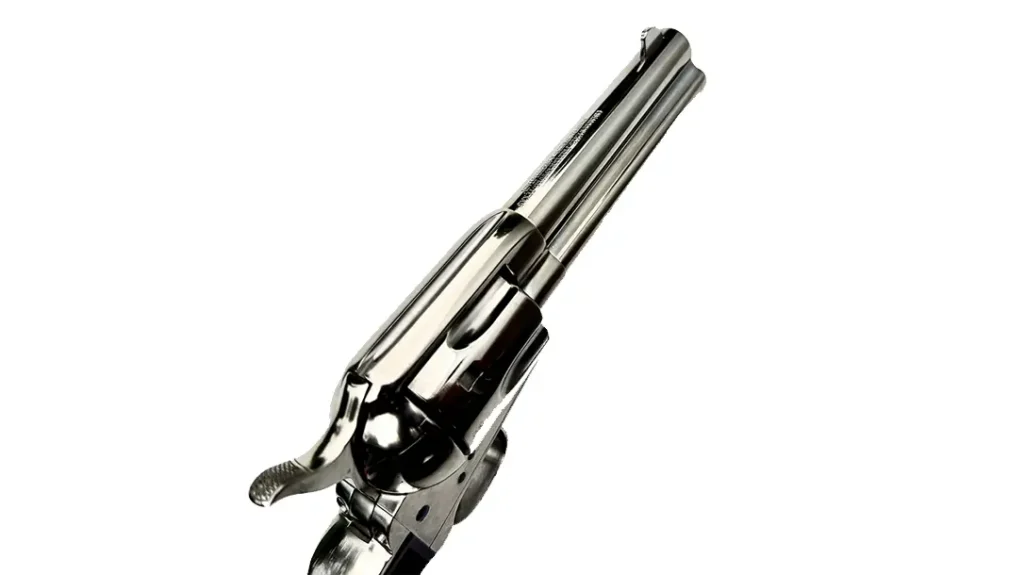
Advertisement — Continue Reading Below
Gunfights on the Border
Kidder was involved in gunfights on the border. In one pitched battle, he shot and wounded one smuggler, while Ranking shot the horse from beneath another. The smugglers absconded, leaving behind some 10,000 rounds of ammunition and other contraband. Kidder’s successes led to his promotion to First Sergeant in 1908, when a new captain, Harry Wheeler, took over. Kidder was well-liked and respected in Nogales despite some shooting scrapes he had been involved in. In each case, he had been exonerated.
Then, on April 1, 1908, Kidder received a letter from Capt. Wheeler advised him that his enlistment in the Rangers had expired and he needed to come to Ranger headquarters in Naco, AT, to be sworn in for another year.
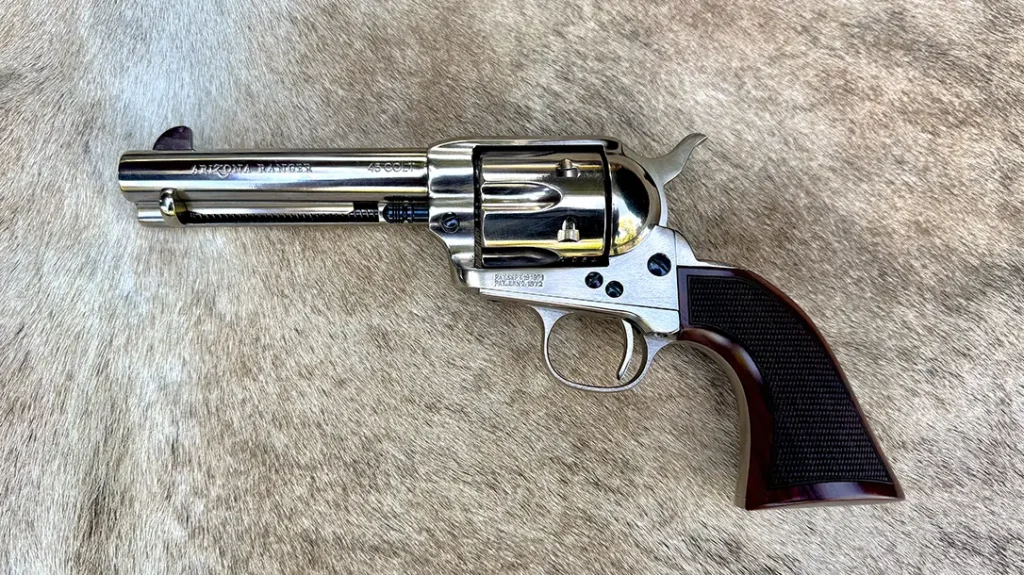
Advertisement — Continue Reading Below
Trouble Brewing
Right across the border in Mexico was Naco, Sonora. Wheeler had told the Rangers to stay away from the town due to the bad feelings the locals had for the “rinches.” Kidder arrived on April 3 and went into Naco, Sonora, to meet with an informant. As a precaution, he’d taken off his gun belt, concealed his Colt under his coat, and slipped six extra cartridges in a pocket. It turns out that around midnight, he was in a cantina seeking information from one of the working girls there.
When he got up to leave, he discovered that a silver dollar he always kept in a vest pocket was missing. Kidder grabbed the girl, accused her of the theft, and an altercation ensued. Apparently, this was a set-up, as when she screamed, “Policia!” two Mexican officials burst in, with guns in hand. One fired, hitting Kidder in the abdomen, near the navel. He drew his six-shooter and returned fire, hitting one in the knee and the other in the thigh. Apparently, they “vamoosed,” as Kidder, in a state of shock, staggered out of the cantina door and headed for the U.S. Border, some 300 yards away.
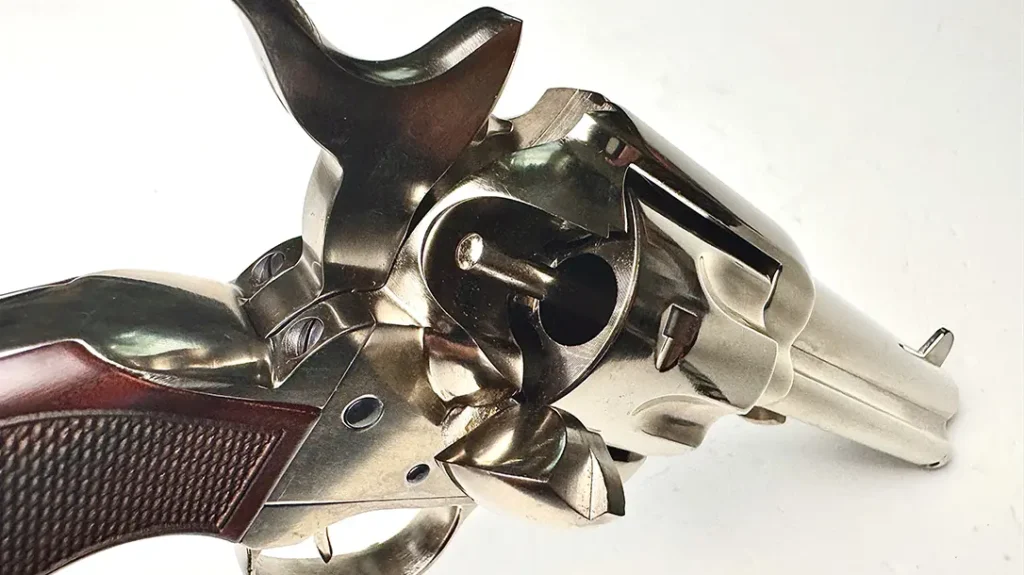
Advertisement — Continue Reading Below
Cimarron’s Arizona Ranger Big Iron Sixgun
Partly to commemorate the Arizona Rangers and a popular song by the late-great musician Marty Robbins, this SA wheelgun was named “Big Iron” after his popular song of the same name. Designed in response to the demands of Western action shooters (WAS), this is a fast-acting six-shooter with features that competitors can appreciate. It comes in several versions, with options including 4.75-, 5.5-, or 7.5-inch barrels, as well as blue or nickel finishes, and chamberings in .357 Magnum, .44 WCF (.44-40), or .45 Colt.
Common features include a wide, square-notch fixed rear sight, mated with a wide constant-width front sight. This allows enhanced target acquisition and quick follow-up shots. There’s also the slender, one-piece walnut grips, fully checkered on the sides, for a firm hold. The Big Iron is built on a post-1896 frame, featuring a spring-loaded base-pin latch, and it comes standard with a checkered spur hammer. On the left side of each barrel is roll-engraved AIRZONA RANGER.
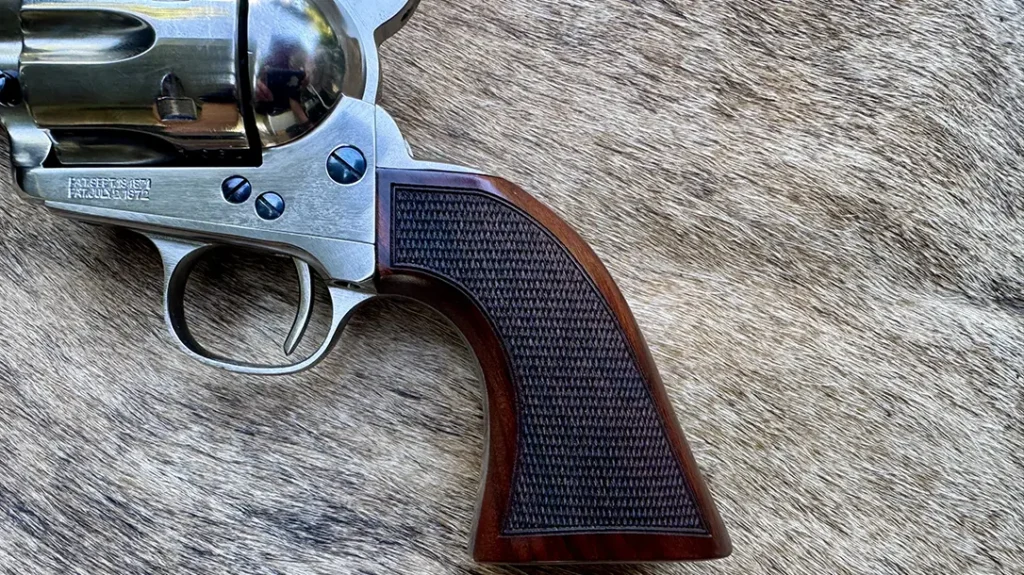
Advertisement — Continue Reading Below
Nickel-Plated
I wanted a nickel-plated Big Iron sixgun in .45 Colt to get as close as I could to the SAA wielded by Ranger Jeff Kidder some 117 years ago. I ended up with one having a 4.75-inch barrel, so I made do. Inspection from fore to aft revealed outstanding care in terms of fit and finish. The polished nickel was attractive and contrasted well with fire-blued screws, base-pin latch, and base pin. I was pleased to see a satin finish on the walnut grips, rather than the reddish lacquer often found on many Uberti-produced replicas.
The fine diamond checkering was well done, with no overruns. Like all good SAA reproductions, it has the “four clicks” as you pull the hammer back to full-cock. The single-action trigger pull weight, as measured by my electronic gauge, averaged 3 lbs. 6 oz. for 10 consecutive pulls. There was no take-up and just a bit of over-travel.
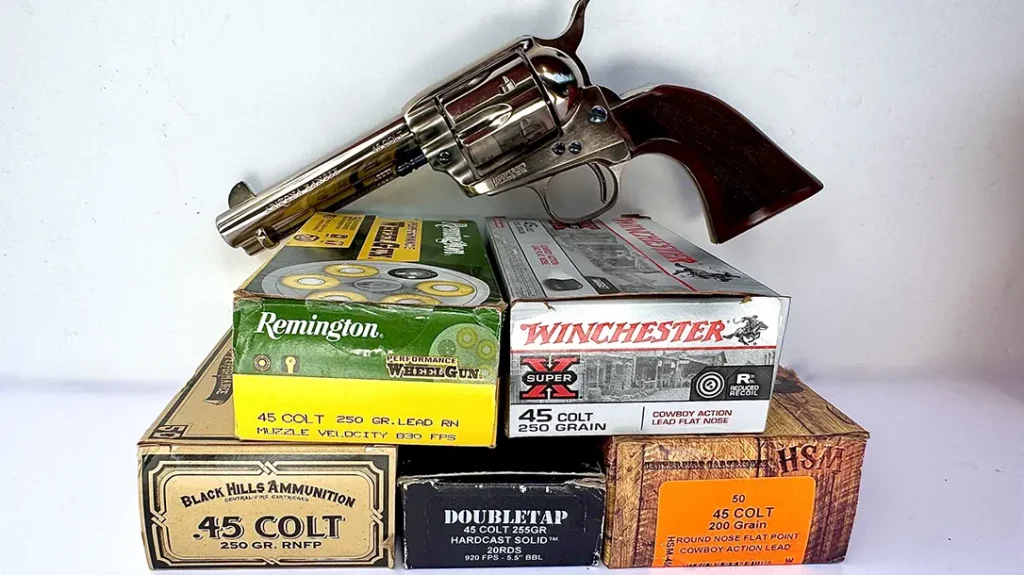
Advertisement — Continue Reading Below
Lead’ n Leather
Five different.45 Colt cartridges were selected for the Big Iron T&E; four are of the “cowboy” type with rounded flat-point lead (RNFP) bullets, and one had semi-wadcutter (SWC) bullets. The first was from Black Hills and is loaded with 250-gr. Bullets. Second up was Doubletap with 255 gr. Hard-cast solid bullets. From Hunting Shack Munitions (HSM) was Cowboy Action Cartridges with a 200-gr. Bullet. Remington provided their Performance Wheelgun cartridges, which carry a 250-grain, rounded bullet, with a small, flat nose that closely resembles those used in the Old West. Last was Winchester Cowboy Action loads that also have a 250-gr. Bullet.
As I planned to use the Arizona Ranger Big Iron in a WAS match, I needed a holster and cartridge belt rig. Galco came through as usual. For a holster, I selected their Model 1880, which is reminiscent of the rigs worn in the Western TV shows of the 1950s-60s. Made of premium full-grain steerhide, dyed a light tan color. It’s based on the single Mexican Loop design but doesn’t have a visible skirt. It’s a high ride, and will fit belts up to 3″ wide, and has a hammer thong retention strap. It was mated with the Model 1880 cartridge belt. The 3″ belt is constructed from premium center-cut steerhide, which has a darker natural color. It provides an attractive contrast with the tan premium steerhide billets and cartridge loops. A nickel-plated brass buckle is standard.
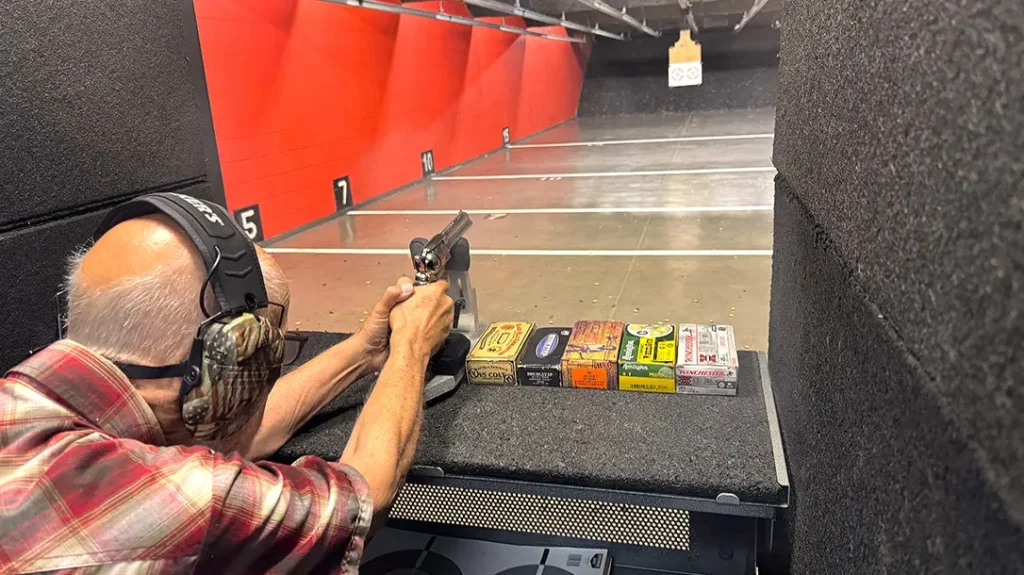
Square Range & Cowboy Shoot
The Big Iron arrived just in time for me to take it to my favorite indoor shooting range, a few days before using it in a cowboy shoot. At the shooting lane, I first set up my Garmin Xero C1 Pro chronograph to get some bullet velocity readings. I also sent a large Caldwell Orange Peel target down to the 10-yard line so I could also get an idea of the gun’s point of aim/point of impact with the .45 Colt test ammo. I noted most of the bullet impacts were just left of center and 1-1.5 inches low, with an X-ring hold.
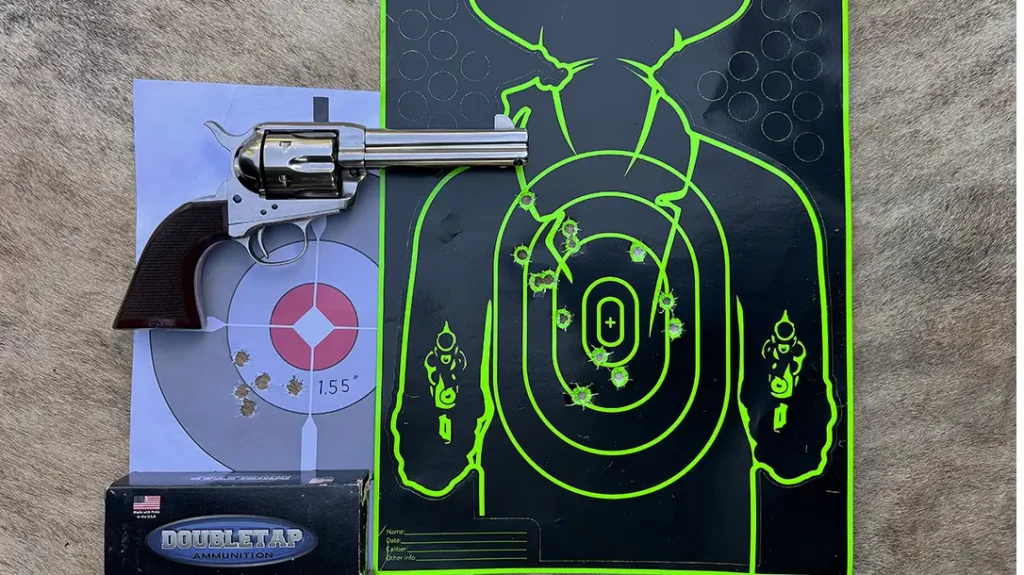
Next, there was some bench rest paper-punching to assess accuracy potential. Shooting was done at 36 feet, using my Ransom Steady Rest and double bullseye targets. Three 5-shot groups were fired with each brand of test ammo. My smallest group measured 1.55 inches and was made using the Doubletap cartridges with its 255 gr. SWC bullet. Second place went to the HSM Cowboy Cartridges, which achieved a 1.66-inch cluster. Group averages ran from 1.66 to 2.43 inches.
Competition Day
As I planned to compete in the one-handed “Duelist” shooting category at the WAS match, I sent a reduced-size “Gunslinger” target from Truglo down to the 10-yard line. The sixgun was loaded with a mix of test cartridges, and starting from low-ready, I raised the Big Iron to eye level and cocked and fired using my right hand only. On shot number 4, I had what I’ll call a “sizzle-pop.” I immediately stopped shooting, and the range RO came over as he had heard it too. Fortunately, the bullet cleared the barrel and didn’t stick in the forcing cone or the bore. Shooting continued. All my shots stayed inside the scoring rings of the silhouette target. I felt confident I’d hit the steel targets on the cowboy town range.
Match day had perfect weather for mid-August in Central Indiana. I was shooting with the Scarlet Mask Vigilance Society, and we had enough shooters to form two good-sized posses. I shot with Posse #2, and we had three main match stages. We broke for lunch and then had three more. As I had a good supply of the Black Hills cowboy cartridges, I used them in the Big Iron during the match.
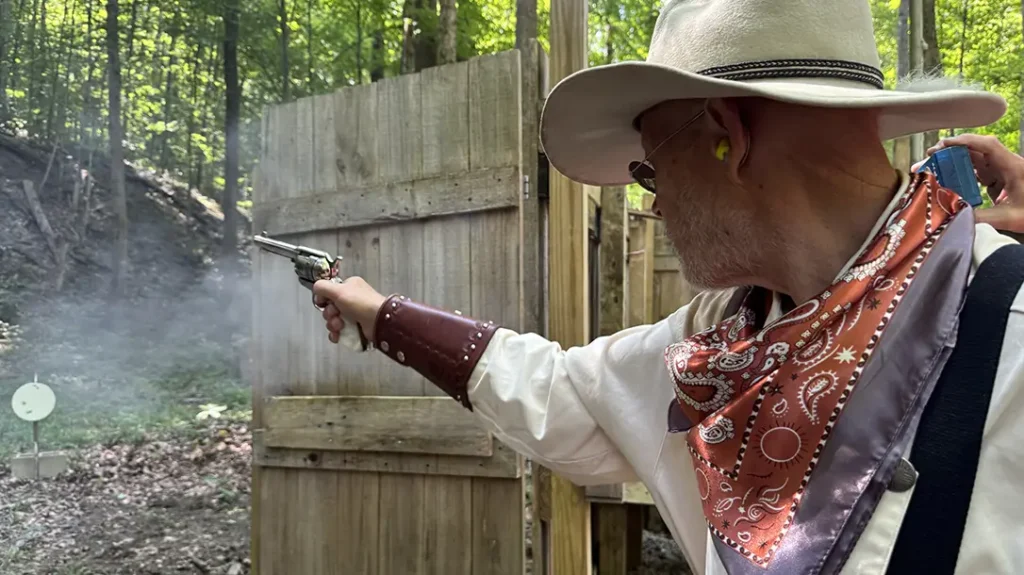
Working Cowboy
My category was “Working Cowboy,” and along with my Cimarron sixgun, I used my Rossi replica Model 92 lever-action gun, also in .45 Colt. At this time, I’m not sure where I placed, as I haven’t received the usual email with the scores. I admit that I was off my game that day and had more misses than usual. I will mention that I swapped out the walnut grips for a set of pearl grips to more closely replicate Jeff Kidder’s sixgun. They actually helped shooting one-handed “Duelist” as I was able to shift my grip and cock the hammer rapidly. When I did my part, the steel rang, and it was a good day.
Back to Naco, Sonora
Unfortunately, the Jeff Kidder story doesn’t have a happy ending. While he managed to stumble to the border fence, he had emptied his gun at the Mexican policia, and was too weak to climb through the strands of barbed wire. He reloaded his gun and shot the Mexican police chief who had charged toward him, then held the rest at bay until his sixgun was again empty. Kidder shouted, “I’m all in!” However, the officers advanced, pistol-whipped him to the ground, and one almost shot him in the head. They took him to the “calaboose,” beat him some more as his gun, badge, and other possessions were taken, and then the Ranger was thrown on the floor of a cell.
Hours later, word reached the American side, and authorities prevailed on a Mexican judge to have Kidder moved to a private residence and be treated by a doctor from Bisbee. The prognosis allowed for little hope, and 30 hours later, Jeff Kidder succumbed to his wounds. It took the threat of 1000 American men who had gathered to storm the border before the Mexican authorities released Kidder’s remains.
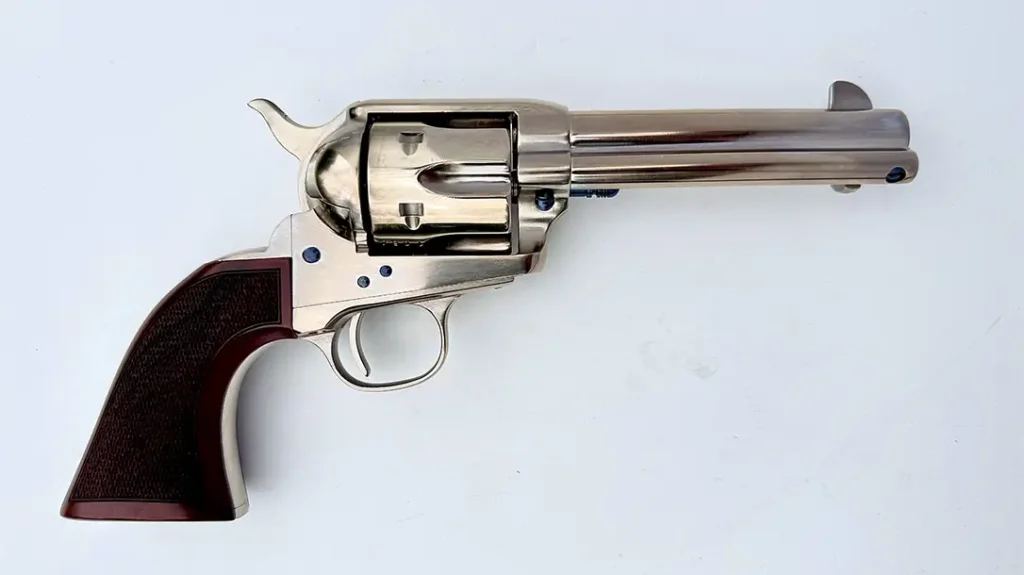
Unhappy Ending
A funeral was held in Bisbee, where Capt. Wheeler eulogized, “Jeff Kidder was one of the best officers who ever stepped foot in this section of the country. He did not know what fear was and was hated by the criminal classes because of his unceasing activity in bringing them to justice.” Kidder’s family resided in San Jacinto, California, and his body was sent there for burial. Due to politics, the Ranger Force was abolished by the Territorial Legislature on February 19, 1909.
For more information, visit Cimarron Firearms.
Cimarron Arizona Ranger Big Iron Specifications
| MECHANISM: | Single action revolver |
| CALIBER: | .45 Colt (or .357 Magnum & .44 WCF) |
| CAPACITY: | 6 cartridges |
| BARREL: | 4.75 in. (or 5.5 & 7.5 in.) |
| OA LENGTH: | 10.35 in. |
| EMPTY WEIGHT: | 38.8 oz. |
| SIGHTS: | Fixed notch rear, blade front |
| FINISH: | Nickel (or blue finish) |
| STOCKS: | One-piece walnut, checkered |
| MSRP: | $ 913.75 |
Cimarron Big Iron .45 Colt Performance
| Cartridge | Ave. Velocity | Best Group | Average Group |
| Black Hills 250 gr. RNFP | 677 FPS | 2.31” | 2.43” |
| Doubletap 255 gr. SWC | 793 FPS | 1.55” | 1.66” |
| HSM 200 gr. RNFP | 730 FPS | 1.66” | 1.86” |
| Remington 250 gr. RNFP | 732 FPS | 1.69” | 1.79” |
| Winchester 250 gr. RNFP | 602 FPS | 1.78” | 1.93” |
NOTE: Bullet weight measured in grains, velocity in feet per second at 15” from the muzzle by a Garmin Xero C1 Pro chronograph, and accuracy in inches for three 5-shot groups at 36 feet.
Read the full article here









